| Description |
Galanthamine is a potent acetylcholinesterase (AChE) inhibitor with an IC50 of 500 nM.
|
| Related Catalog |
|
| Target |
IC50: 0.5 μM (AChE)[1]
|
| In Vitro |
Galanthamine inhibits AChE and BChE with IC50 of 0.5 and 8.5 μM[1]. Galanthamine acts as a positive allosteric modulator (PAM) of human α4β2 AChRs expressed in permanently transfected HEK 293 cells. Galanthamine increases the response of (α4β2)2α5 AChRs to 1 μM ACh by up to 220% with very low concerntration(EC50=0.25 nM). Only small potentiation (20%) of either α4β2 or (α4β2)2β3 AChRs is detected using FLEXstation assays. Galanthamine at concentrations of 1 μM and above inhibits all three AChR subtypes[2].
|
| In Vivo |
Acute administration of Galantamine (0.3-3 mg/kg, i.p.) increases IGF2 mRNA levels in the hippocampus, but not in the prefrontal cortex, in time- and dose-dependent manner. Galantamine (3 mg/kg, i.p.) causes a transient increase in fibroblast growth factor 2 mRNA levels and a decrease in brain-derived neurotrophic factor mRNA levels in the hippocampus, while it does not affect the mRNA levels of other neurotrophic/growth factors. The Galantamine-induced increase in the hippocampal IGF2 mRNA levels is blocked by Mecamylamine, a nonselective nicotinic acetylcholine (ACh) receptor (nAChR) antagonist, and Methyllycaconitine, a selective α7 nAChR antagonist, but not by Telenzepine, a preferential M1muscarinic ACh receptor antagonist. Moreover, the selective α7 nAChR agonist PHA-543613 increasea the IGF2 mRNA levels, while Donepezil, an acetylcholinesterase inhibitor, does not. Galantamine also increases hippocampal IGF2 protein, which is blocked by Methyllycaconitine[2].
|
| Animal Admin |
Mice[2] Eight-week-old male ddY mice are housed in cages (24 cm×17 cm×12 cm) in each group of five to six animals under controlled environmental conditions (22±1°C; 12:12-h light-dark cycle, lights on at 0800 hours, food and water ad libitum) for 1 week before use in the experiments. 453 mice are used in total and in single use for each purpose. The following drugs are used: mecamylamine, methyllycaconitine, oxotremorine, and telenzepine, and Galantamine, Donepezil, and PHA-543613. All drugs are dissolved in saline (0.9 % solution of NaCl). Drugs are administered in a volume of 10 mL/kg intraperitoneally (i.p.) (Galantamine, Donepezil, Mecamylamine, Methyllycaconitine, Oxotremorine) or subcutaneously (s.c.) (PHA-543613, Telenzepine).
|
| References |
[1]. Melanie-Jayne R. Howes, et al. Acetylcholinesterase inhibitors of natural origin. International Journal of Research in Pharmaceutical and Biomedical Sciences 3(SI 1):67-86. [2]. Kuryatov A, et al. Roles of accessory subunits in alpha4beta2(*) nicotinic receptors. Mol Pharmacol. 2008 Jul;74(1):132-43. [3]. Kita Y, et al. Galantamine increases hippocampal insulin-like growth factor 2 expression via α7 nicotinic acetylcholine receptors in mice. Psychopharmacology (Berl). 2013 Feb;225(3):543-51.
|
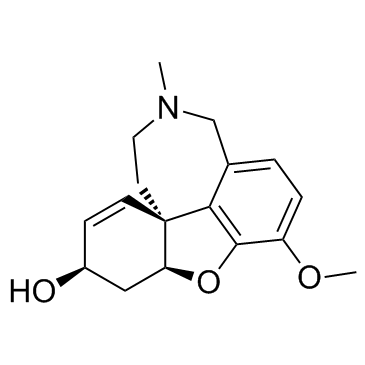
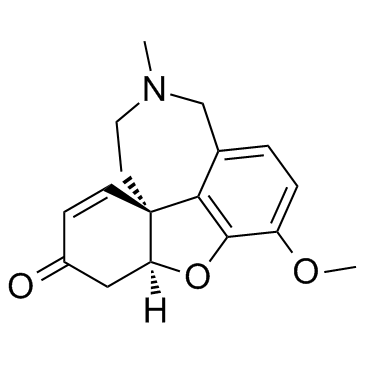 CAS#:510-77-0
CAS#:510-77-0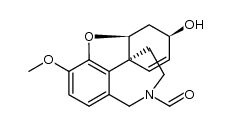 CAS#:109606-37-3
CAS#:109606-37-3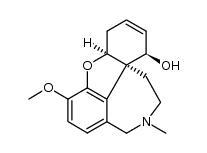 CAS#:313047-12-0
CAS#:313047-12-0![(4aR,6S,8aR)-4a,5,11,12-tetrahydro-6-hydroxy-3-methoxy-11-methyl-6H-benzofuro[3a,3,2-ef][2]-benzazepin-10(9H)-one Structure](https://image.chemsrc.com/caspic/019/869369-22-2.png) CAS#:869369-22-2
CAS#:869369-22-2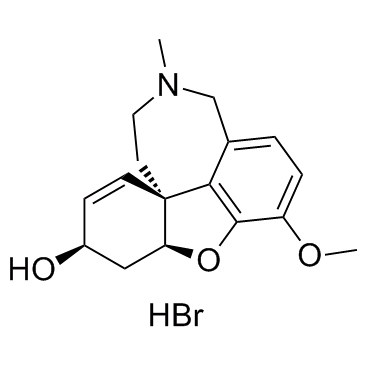 CAS#:1953-04-4
CAS#:1953-04-4![(2S,5R)-5-benzyl-2-(3,5-dibenzyloxy-4-methoxyphenyl)-3-[2-(4-hydroxyphenyl)ethyl]imidazolidin-4-one Structure](https://image.chemsrc.com/caspic/029/722499-71-0.png) CAS#:722499-71-0
CAS#:722499-71-0![(4aS,8aS,13R,14aR)-13-benzyl-2-hydroxy-3-methoxy-14-(2,2,2-trifluoroacetyl)-4a,5,9,10,14,14a-hexahydro-6H-benzo[2,3]benzofuro[4,3-cd]imidazo[1,2-a]azepine-6,12(13H)-dione Structure](https://image.chemsrc.com/caspic/415/722499-74-3.png) CAS#:722499-74-3
CAS#:722499-74-3![(4aS,8aS,13R,14aR)-13-benzyl-3-methoxy-6,12-dioxo-14-(2,2,2-trifluoroacetyl)-4a,5,9,10,12,13,14,14a-octahydro-6H-benzo[2,3]benzofuro[4,3-cd]imidazo[1,2-a]azepin-2-yl trifluoromethanesulfonate Structure](https://image.chemsrc.com/caspic/360/722499-80-1.png) CAS#:722499-80-1
CAS#:722499-80-1![(2R,11bR)-2-benzyl-8,10-bis(benzyloxy)-9-methoxy-1-(2,2,2-trifluoroacetyl)-1,5,6,11b-tetrahydrospiro[benzo[c]imidazo[1,2-a]azepine-7,1'-cyclohexane]-2',5'-diene-3,4'(2H)-dione Structure](https://image.chemsrc.com/caspic/453/722499-73-2.png) CAS#:722499-73-2
CAS#:722499-73-2![(2S,5R)-5-benzyl-2-(3,5-dibenzyloxy-4-methoxyphenyl)-3-[2-(4-hydroxyphenyl)ethyl]-1-(2,2,2-trifluoroacetyl)imidazolidin-4-one Structure](https://image.chemsrc.com/caspic/491/722499-72-1.png) CAS#:722499-72-1
CAS#:722499-72-1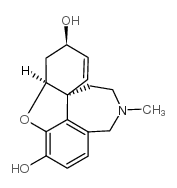 CAS#:60755-80-8
CAS#:60755-80-8 CAS#:41303-74-6
CAS#:41303-74-6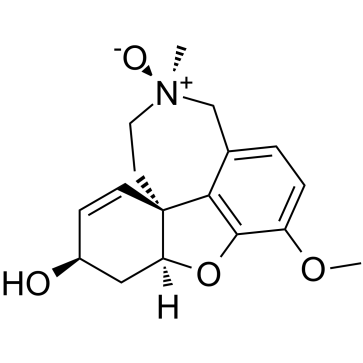 CAS#:134332-50-6
CAS#:134332-50-6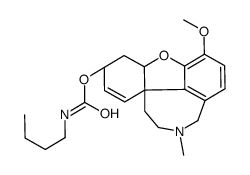 CAS#:138963-44-7
CAS#:138963-44-7
